-
01-01-2016
ERRATUM
Revista Brasileira de Enfermagem. 2016;69(1):206-206
Abstract
ERRATUM
Revista Brasileira de Enfermagem. 2016;69(1):206-206
DOI 10.1590/0034-7167.20166901e02
Views0In the article “Conceptions of mid-level nursing professionals facing those with a chemical dependency”, with the number of DOI: 10.1590/0034-7167.2015680610i, published in the journal Revista Brasileira de Enfermagem, v68(6):755-60, page 760 that read: “8. Vargas D, Soares J. Knowledge and attitudes of nurses towards alcohol and related problems: the impact of an educational intervention. Rev […]See more -
01-01-2016
ERRATUM
Revista Brasileira de Enfermagem. 2016;69(1):205-205
Abstract
ERRATUM
Revista Brasileira de Enfermagem. 2016;69(1):205-205
DOI 10.1590/0034-7167.20166901e01
Views0In the article “Using the theory of meaningful learning in nursing education”, with the number of DOI: 10.1590/0034-7167.2015680420i, published in the journal Revista Brasileira de Enfermagem, v68(4):626-35, page 627 that read:“Ausubel was descended from Jewish, born in New York in 1918 and died in 1994 at the age of 75. He thought and wrote until […]See more -
01-01-2016
Nursing process documentation: rationale and methods of analytical study
Revista Brasileira de Enfermagem. 2016;69(1):197-204
Abstract
Nursing process documentation: rationale and methods of analytical study
Revista Brasileira de Enfermagem. 2016;69(1):197-204
DOI 10.1590/0034-7167.2016690126i
Views0See moreABSTRACT
Objective:
to describe the methods used to analyze the associations between variables of service, nursing and the nursing process documentation in institutions of the Department of Health of the State of São Paulo.
Method:
multilevel analytical study with data obtained in the domains of institution, units of the institution and nursing professionals who work there, using standardized instruments. The analyses had as axis the degree of completeness of the nursing process documentation in units or institutions and their association with variables of nursing personnel, of units and of institutions.
Conclusion:
This study will provide important empirical evidence on the factors involved in the nursing process documentation.
-
01-01-2016
Qualitative methodologies in health research: interpretive referential of Patricia Benner
Revista Brasileira de Enfermagem. 2016;69(1):192-196
Abstract
Qualitative methodologies in health research: interpretive referential of Patricia Benner
Revista Brasileira de Enfermagem. 2016;69(1):192-196
DOI 10.1590/0034-7167.2016690125i
Views0See moreABSTRACT
Objective:
this article reports on the experience of using the interpretive phenomenological framework of Patricia Benner in a Brazilian context. Benner’s interpretive phenomenology, based on existential and interpretative philosophy, aims to understand human experiences in the particular worlds of research participants. Data were collected through interviews with nine nurses in November and December 2014.
Results:
data analysis process according to Benner’s framework consisted of: transcription, coding, thematic analysis, and search for paradigmatic cases and examples. Therefore, the prior knowledge of the researcher is an important part of the study, consisting in manners of the research conduction.
Conclusion:
The use of this methodological framework entailed a great challenge for the researcher, however, it also enabled a unique opportunity to illuminate important existential phenomena related to the daily lives of research participants.
-
01-01-2016
Nurses’ performance on primary care in the National Health Service in England
Revista Brasileira de Enfermagem. 2016;69(1):182-191
Abstract
Nurses’ performance on primary care in the National Health Service in England
Revista Brasileira de Enfermagem. 2016;69(1):182-191
DOI 10.1590/0034-7167.2016690124i
Views0See moreABSTRACT
Objective:
To analyze the expansion of nursing roles in primary care in the English National Health Service and the implications for professional practice.
Method:
qualitative research in case study format, held in London, England, in six primary care units. Data were obtained through interviews with nine nurses. After the thematic data analysis, two units emerged: the nurses’ performance characteristics and effects of the expansion of nursing roles.
Results:
expansion of nurses’ roles: consultation, diagnosis and drug therapy, case management and monitoring of chronic conditions. Repercussions: for the user, there was improved access, communication and comprehensive care, increased duration of consultations, resulting in greater adherence; for nurses, there was the expansion of professional skills, knowledge and professional recognition; to the health care system, it resulted in cost savings.
Conclusion:
benefits in expanding nursing roles, were visible, contributing to primary care quality.
-
01-01-2016
Meleis’ Nursing Theories Evaluation: integrative review
Revista Brasileira de Enfermagem. 2016;69(1):174-181
Abstract
Meleis’ Nursing Theories Evaluation: integrative review
Revista Brasileira de Enfermagem. 2016;69(1):174-181
DOI 10.1590/0034-7167.2016690123i
Views0See moreABSTRACT
Objective:
to analyze the application of the theory evaluation model proposed by Meleis in Brazilian studies.
Method:
integrative review of online articles published from 2002 to 2012 in the databases LILACS and BDENF.
Results:
the 16 selected studies confirmed the use of only three of the five stages proposed for Meleis’ theories analysis: Description of the Theory, Criticism of the Theory and Analysis of the Theory, with a predominance of a single unit of analysis in each.
Conclusion:
the analysis of nursing theories provides support to nurses in the practice, research, education and administration of the different dimensions of care. Meleis’ model figures as very important by contributing to the development of knowledge of nursing discipline, considering that its use as a method allows several reflections on theories in order that they be revalidated to support a more theoretical and practical applicability.
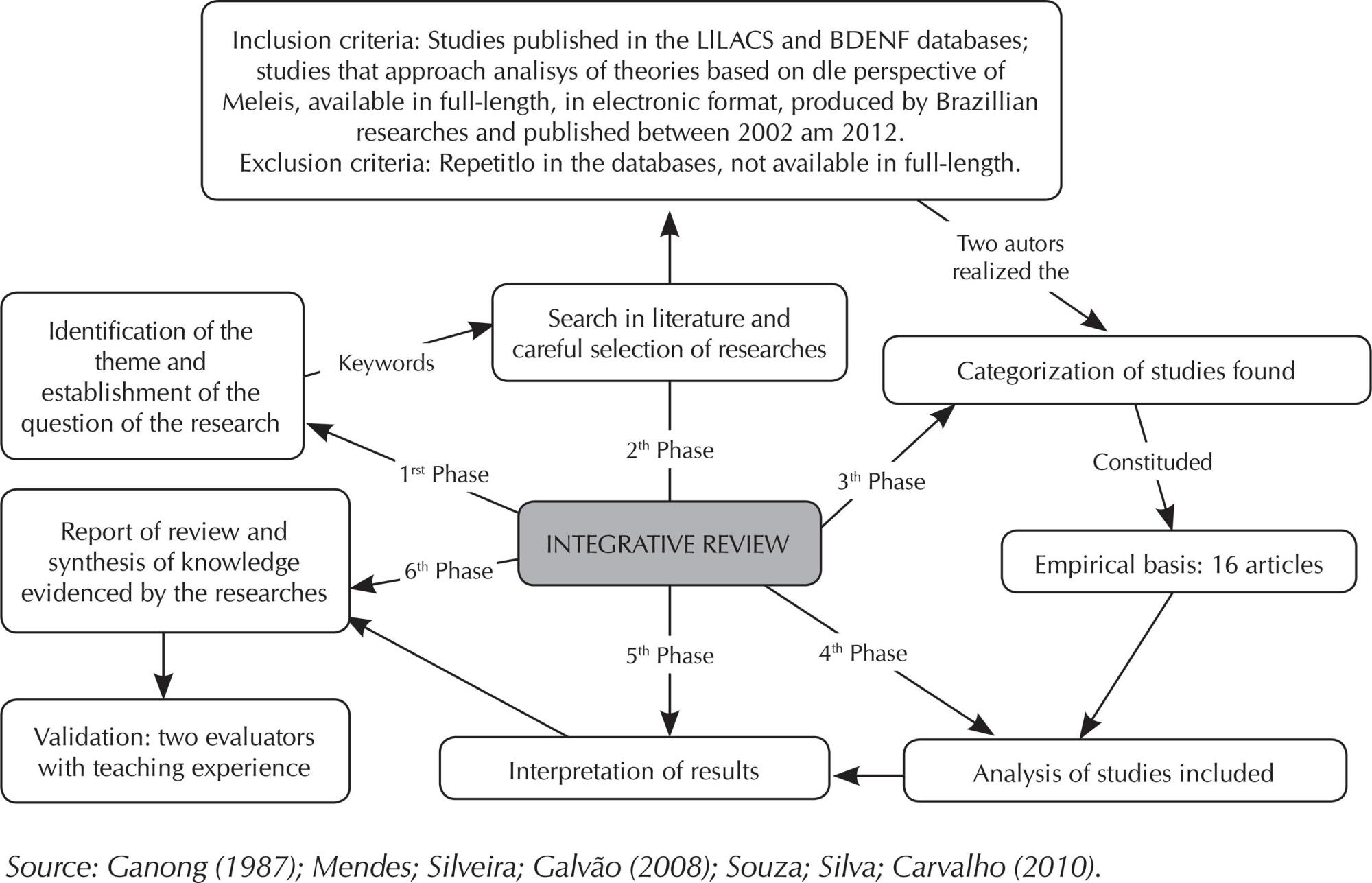
-
01-01-2016
Clinical indicators of sexual dysfunction in pregnant women: integrative literature review
Revista Brasileira de Enfermagem. 2016;69(1):165-173
Abstract
Clinical indicators of sexual dysfunction in pregnant women: integrative literature review
Revista Brasileira de Enfermagem. 2016;69(1):165-173
DOI 10.1590/0034-7167.2016690122i
Views0See moreABSTRACT
Objective:
to identify the nursing diagnosis clinical indicators of sexual dysfunction in pregnant women.
Method:
it is an integrative literature review, with research in databases using the keywords “sexual*”, “pregnan*” and “function*”. Studies included had an abstract available for analysis, referring to pregnant women over 18 years old, written in Portuguese, French, Spanish and English, with publication date between 2010 and 2014. Studies that reporting pregnant women with an associated pathology were excluded.
Results:
sexual dysfunction in pregnant women is consistent in the literature. Nine defining characteristics were identified and 16 related factors, some not classified in NANDA International.
Conclusion:
clinical indicators can be added to the nursing diagnosis to favor an accurate diagnosis and effective interventions in the surveillance of pregnancy as a period of healthy sexual experience.
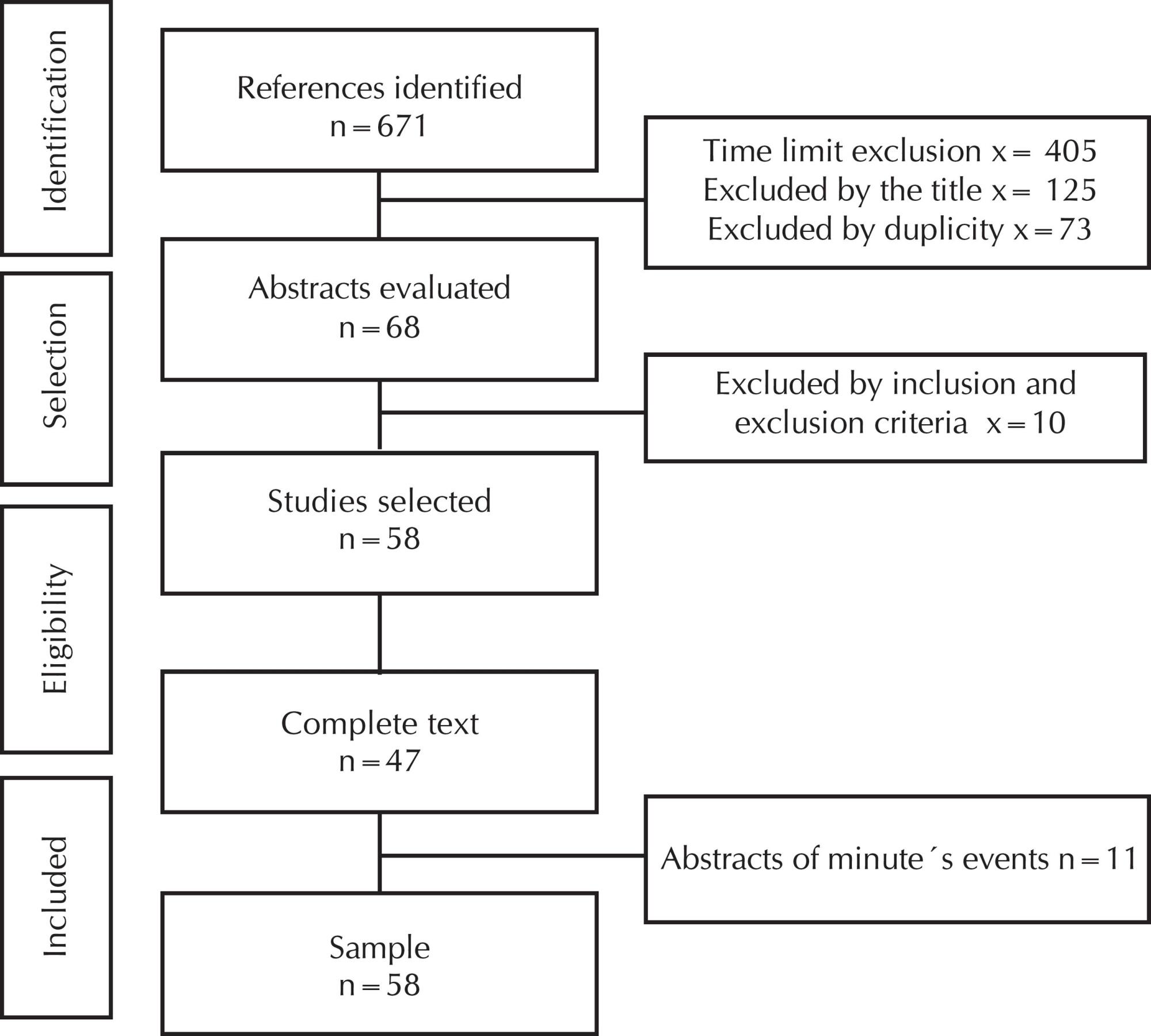
-
01-01-2016
Conditions of functional health literacy of an elderly diabetics group
Revista Brasileira de Enfermagem. 2016;69(1):156-164
Abstract
Conditions of functional health literacy of an elderly diabetics group
Revista Brasileira de Enfermagem. 2016;69(1):156-164
DOI 10.1590/0034-7167.2016690121i
Views0See moreABSTRACT
Objective:
to evaluate the conditions of functional health literacy of an elderly diabetics group.
Method:
cross-sectional and descriptive study, with diabetic’s elderly assisted in the SUS (N = 114). The social and health conditions were evaluated as well as functional health literacy by S-TOFHLA test (short version); the simple proportions, average, standard deviation and Pearson’s Chi-square were described by SPSS software (20.0) with α = 5% value.
Results:
the mean age was 67.4 years, 74.0% of the elderly were women, had up to four years of schooling; 29.8% had a long-standing illness, 64.0% reported having high blood pressure, 47.4% smoke or were smokers, 73.7% had low functional health literacy, which was associated with schooling p = 0.001.
Conclusions:
the low functional health literacy could be a self-care conditioning and can be influenced by low schooling because it implies to have skills to understand and make decisions aimed at self-management of health.
-
01-01-2015
Ineffective airway clearance: accuracy of clinical indicators in asthmatic children
Revista Brasileira de Enfermagem. 2015;68(5):862-868
Abstract
Ineffective airway clearance: accuracy of clinical indicators in asthmatic children
Revista Brasileira de Enfermagem. 2015;68(5):862-868
DOI 10.1590/0034-7167.2015680514i
Views0See moreABSTRACT
Objective:
to analyze the accuracy measurements of clinical indicators of the nursing diagnosis Ineffective airway clearance.
Method:
cross-sectional study with 205 asthmatic children treated in the emergency unit of a hospital in the city of Fortaleza, Ceará. An interview script and pulmonary evaluation were used for data collection.
Results:
the diagnosis of Ineffective airway clearance was present in 89.3% of the sample. The most prevalent clinical indicators were dyspnea, change in respiratory rate, change in respiratory rhythm, orthopnea, adventitious respiratory sounds and ineffective cough. The clinical indicators with highest sensitivity were dyspnea, change in respiratory rate, change in respiratory rhythm, orthopnea and adventitious respiratory sounds. Ineffective cough and adventitious respiratory sounds were the indicators with best specifi city.
Conclusion:
the clinical indicator adventitious respiratory sounds was the best predictor of Ineffective airway clearance in asthmatic children treated in emergency units.
-
01-01-2015
Mortality from external causes in Pernambuco, 2001-2003 and 2011-2013
Revista Brasileira de Enfermagem. 2015;68(5):855-861
Abstract
Mortality from external causes in Pernambuco, 2001-2003 and 2011-2013
Revista Brasileira de Enfermagem. 2015;68(5):855-861
DOI 10.1590/0034-7167.2015680513i
Views0See moreABSTRACT
Objective:
to describe the mortality from external causes, by Health Regions in Pernambuco, during the periods of2001-2003 and 2011-2013.
Method:
descriptive study with data from the Mortality Information System. For data analysis we used percentage, percentage variation and proportion ratio.
Results:
mortality from external causes reduced in Pernambuco, however, mortality increased in some health regions of the countryside. Increased numbers of deaths from accidents and event of undetermined intent were registered. There was an increase of deaths classified as “other/unspecified” event of undetermined intent.
Conclusion:
there was a change in the spatial distribution of mortality from external causes moving to Pernambuco countryside regions. We found necessity for data classification regarding deaths from external causes and strengthening of the monitoring.
-
01-01-2015
Evaluation of scientific production, patents and human resources training in the Brazilian nursing
Revista Brasileira de Enfermagem. 2015;68(5):846-854
Abstract
Evaluation of scientific production, patents and human resources training in the Brazilian nursing
Revista Brasileira de Enfermagem. 2015;68(5):846-854
DOI 10.1590/0034-7167.2015680512i
Views0See moreABSTRACT
Objective:
to evaluate scientifi c production, patents and human resources training of nursing researchers with scholarships of research productivity (PQ) in National Counsel for Technological and Scientific Development (CNPq) in the 2000-2012 historic series; to verify the association between this production and characteristics of the researchers regarding gender, education and origin.
Methods:
this analytic cross-sectional study whose inclusion criterion was to be a nursing PQ/CNPq researcher during the period in question. We analyzed curriculum lattes of 208 researchers with scholarships between 2000 and 2012. For statistical analyses we used the SPSS® software.
Results:
the study points to female predominance, concentration in the Southeast region and existence of an association between scientific production, patents and human resources training and education, gender and origin of the researcher.
Conclusion:
the study presents a significant participation of nursing PQ/CNPq researchers in scientific production and in human resources training, and a modest involvement in the production of patents.
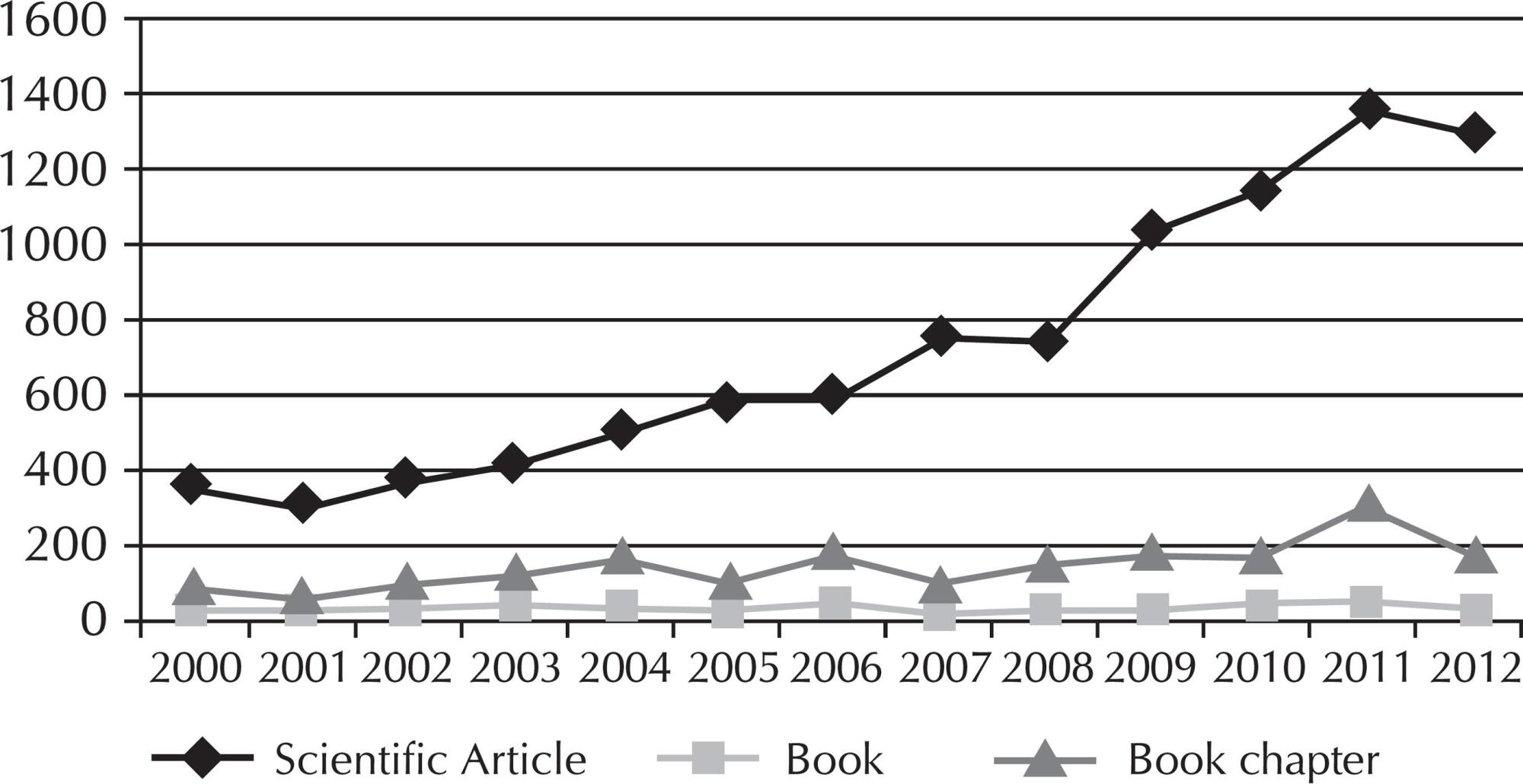
-
01-01-2015
Structure, process and outcomes of organ and tissue donation for transplantation
Revista Brasileira de Enfermagem. 2015;68(5):837-845
Abstract
Structure, process and outcomes of organ and tissue donation for transplantation
Revista Brasileira de Enfermagem. 2015;68(5):837-845
DOI 10.1590/0034-7167.2015680511i
Views0See moreABSTRACT
Objective:
to analyze the factors related to the structure, process and outcomes of organ and tissue donation for transplantation.
Method:
analytic, longitudinal and quantitative study, conducted in six hospitals in Natal/RN, between August 2010 and February 2011, with 65 potential donors (PD), by means of no participant observation structured script.
Results:
regarding the donation structure, there was deficiencies of physical resources (temperature control), materials (mobile radiology) human resources (nurse technicians) and lack of adequate records and care protocols. In the process of donation, the biggest problems were related to the evaluation stages, brain death diagnosis, maintenance and documentation, with greater proportion of care for the non-donor.
Conclusion:
the structure and process possibly determined the result of 72.3% no donation implementation of potential donors, indices compatible with the national data, but contradictory to those of Spain, which manages to transplant organs of 86.7% of its donors.
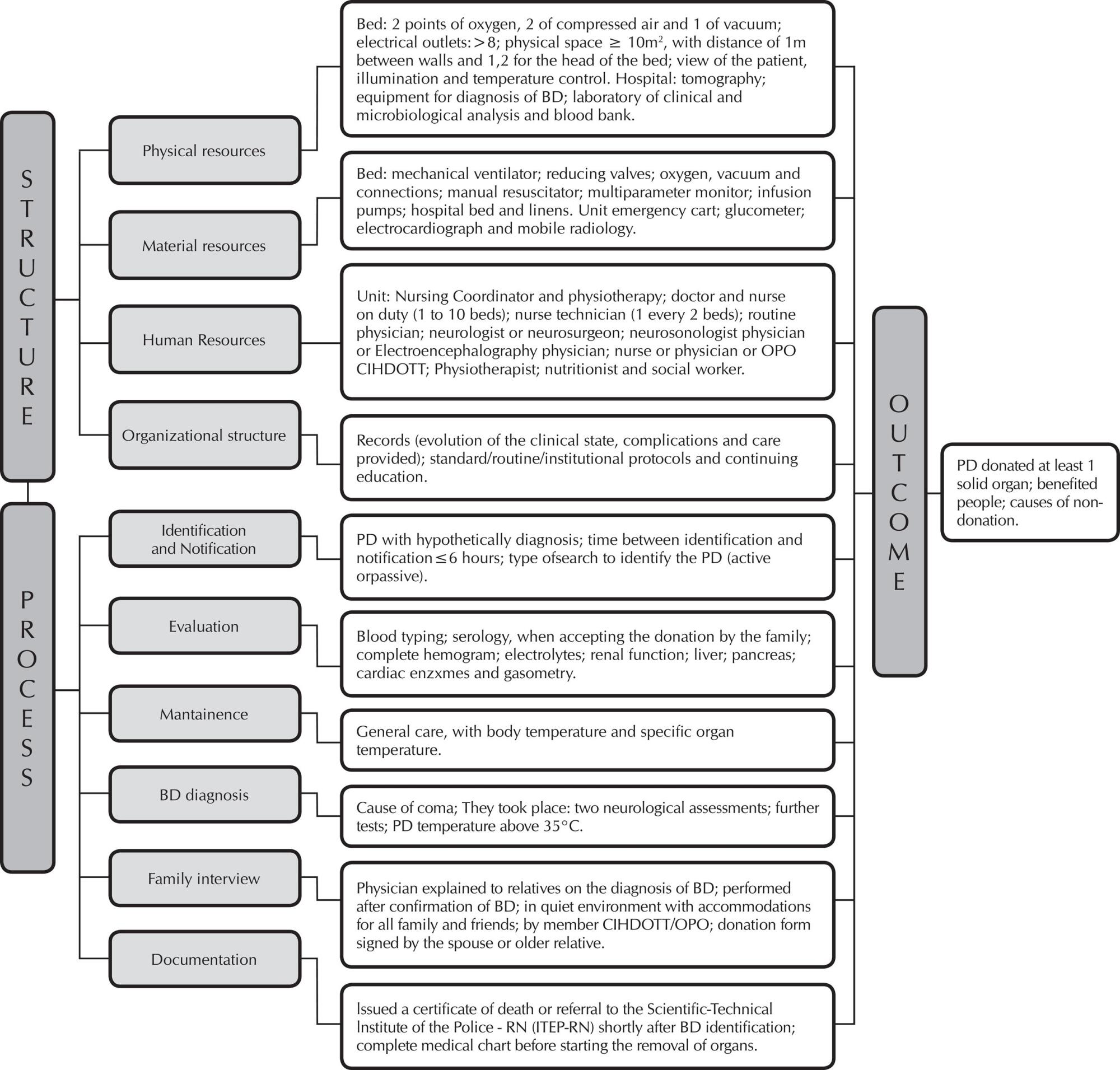
-
01-01-2015
The nurse in the area of collective health: conceptions and competencies
Revista Brasileira de Enfermagem. 2015;68(5):830-836
Abstract
The nurse in the area of collective health: conceptions and competencies
Revista Brasileira de Enfermagem. 2015;68(5):830-836
DOI 10.1590/0034-7167.2015680510i
Views0See moreABSTRACT
Objective:
to learn coordinators and professors’ conceptions from undergraduate Nursing courses of public universities in northern Brazil regarding collective health and to know the necessary competencies to work in the area.
Method:
data were collected through semi-structured interviews and subjected to thematic analysis.
Results:
the participants consider population health as an essential area for the training of nurses, where professionals have autonomy and confidence. It is an interdisciplinary, intersectoral and multidisciplinary field, with extensive scope, that studies the Unified Health System (SUS). The competencies to work in collective health identified were: to work at the SUS, to understand the health and disease process and its determinants and to develop actions towards integrality, to conduct health education, researches and systematization of the nursing care.
Conclusion:
the variety of conceptions about collective health among participants might reflect in training of nurses and their working area.
-
01-01-2015
Level of dependence among patients in a surgical unit
Revista Brasileira de Enfermagem. 2015;68(5):824-829
Abstract
Level of dependence among patients in a surgical unit
Revista Brasileira de Enfermagem. 2015;68(5):824-829
DOI 10.1590/0034-7167.2015680509i
Views0See moreABSTRACT
Objective:
to identify the complexity of the nursing care of inpatient surgical unit patients, using the Perroca patients classification scale.
Method:
a descriptive, cross-sectional study with 546 reviews of 187 patients between October and December of 2012. Data were analyzed using SPSS 18.0 and the Kappa test, to measure interrater agreement.
Results:
a predominance of patients in the categories of semi-intensive (46.5%) and intermediate care (44.0%) was found, with a prevalence of unassisted bath (58.4%) in the total sample, and bed bath (69.3%) in the semi-intensive care patients. The level of agreement between two pairs of raters was considered good.
Conclusion:
the systematic application of the instrument was useful as a complementary measure of the level of patient dependence, and may contribute to the improvement of the working process, refl ecting on management decision-making with regard to nursing workload
-
01-01-2015
Psychological violence in the nursing work
Revista Brasileira de Enfermagem. 2015;68(5):817-823
Abstract
Psychological violence in the nursing work
Revista Brasileira de Enfermagem. 2015;68(5):817-823
DOI 10.1590/0034-7167.2015680508i
Views0See moreABSTRACT
Objective:
to investigate and characterize psychological violence practices within teams in the relationship between patients, caregivers and other professionals with the nursing staff of the public hospital network of Caxias, in the State of Maranhão, Brazil.
Method:
descriptive, quantitative, cross-sectional study with data collected by form between November/2013-May/2014.
Results:
verbal aggression is the most common psychological violence subtype 95% (84), followed by bullying 27% (24). Emergency rooms 51% (45) are the most frequent place; patients 60% (53) are the main aggressors; nurses 76% (19) suffer more violence, being mostly female, young and inexperienced.
Conclusion:
the largest number of occurrences was of verbal aggression perpetrated by patients against nurses in the emergency room. Workers try to pretend that nothing happened or are inert in the face of violence. Employers do little about the case, referring to the need for strategies to control violence.
-
01-01-2015
Dietary intake and stress in patients with acute coronary syndrome
Revista Brasileira de Enfermagem. 2015;68(5):810-816
Abstract
Dietary intake and stress in patients with acute coronary syndrome
Revista Brasileira de Enfermagem. 2015;68(5):810-816
DOI 10.1590/0034-7167.2015680507i
Views0See moreABSTRACT
Objective:
to assess whether dietary intake of patients with acute coronary syndrome (ACS) meets national and international recommendations and whether there is a relationship with the levels of stress.
Method:
a cross-sectional study with 150 patients with ACS, who were interviewed with the Food Frequency Questionnaire and the Perceived Stress Scale-10.
Results:
daily intake above the recommendations: cholesterol (92%), fiber (42.7%) and protein (68%); intake below the recommendations: potassium (88%) and carbohydrates (68.7%); intake according to the recommendations: sodium (53.3%) and lipids (53.3%). Most patients with inadequate dietary intake (54%) were stressed or highly stressed. There was a signifi cant association between a lower stress level and a higher fi ber intake.
Conclusion:
in patients with ACS, dietary intake did not meet the guideline recommendations, and a lower fi ber intake occurs concomitantly with higher stress levels. Educational efforts can support patients in dietary intake adequacy and stress control.
-
RESEARCH01-01-2017
Violence against children and adolescents: the perspective of Primary Health Care
Revista Brasileira de Enfermagem. 2017;70(3):511-518
Abstract
RESEARCHViolence against children and adolescents: the perspective of Primary Health Care
Revista Brasileira de Enfermagem. 2017;70(3):511-518
DOI 10.1590/0034-7167-2016-0471
Views0See moreABSTRACT
Objective:
To analyze the care provided by Basic Health Units (BHU) to families involved in domestic intrafamily violence against children and adolescents.
Method:
Qualitative research, based on the Paradigm of Complexity. Data collection was performed with 41 professionals through focus groups and semi-structured interviews.
Results:
The following categories emerged from data analysis: ‘Everything comes here’, which reflects the legitimate place of BHUs for the population and the actions taken to build care for families; and ‘We only do what is really necessary’, which brings the look to violence still based on the positivist and biomedical paradigm.
Final considerations:
The model of understanding and construction of work processes in the BHU is structured in the aforementioned paradigm. Nurses have the possibility to become agents of change, both in professionals’ training and in the care thought and provided to communities.
-
RESEARCH01-01-2017
Integrality of care: challenges for the nurse practice
Revista Brasileira de Enfermagem. 2017;70(3):504-510
Abstract
RESEARCHIntegrality of care: challenges for the nurse practice
Revista Brasileira de Enfermagem. 2017;70(3):504-510
DOI 10.1590/0034-7167-2016-0380
Views0See moreABSTRACT
Objective:
to understand the role of the nurse in the collegiate management model of a teaching hospital, in the integrality of care perspective.
Method:
a single case study with multiple units of analysis, with the theoretical proposition “integrality of care is a result of the care offered to the user by multiple professionals, including the nurse”. Data were obtained in a functional unit of a teaching hospital through interviews with 13 nurses in a non-participant observation and document analysis.
Results:
from the analytical categories emerged subcategories that allowed understanding that the nurse promotes integrality of care through nursing management, team work and integration of services.
Final considerations:
the theoretical proposition was confirmed and it was verified that the nursing management focus on attending to health care needs and is a strategy to provide integrality of care.
-
RESEARCH01-01-2017
Low completion rate of hepatitis B vaccination in female sex workers
Revista Brasileira de Enfermagem. 2017;70(3):489-494
Abstract
RESEARCHLow completion rate of hepatitis B vaccination in female sex workers
Revista Brasileira de Enfermagem. 2017;70(3):489-494
DOI 10.1590/0034-7167-2016-0567
Views0See moreABSTRACT
Objective:
to assess predictive factors for noncompletion of the hepatitis B vaccination schedule in female sex workers in the city of Teresina, Northeastern Brazil.
Method:
402 women were interviewed and, for those who did not wish to visit specialized sites, or did not know their hepatitis B vaccination status, the vaccine was offered at their workplaces. Bi- and multivariate analyses were performed to identify potential predictors for noncompletion of the vaccination schedule.
Results:
of the 284 women eligible for vaccination, 258 (90.8%) received the second dose, 157/258 (60.8%) and 68/258 (26.3%) received the second and third doses, respectively. Working at clubs and consuming illicit drugs were predictors for noncompletion of the vaccination schedule.
Conclusion:
the high acceptability of the vaccine’s first dose, associated with low completion rates of the vaccination schedule in sex workers, shows the need for more persuasive strategies that go beyond offering the vaccine at their workplaces.
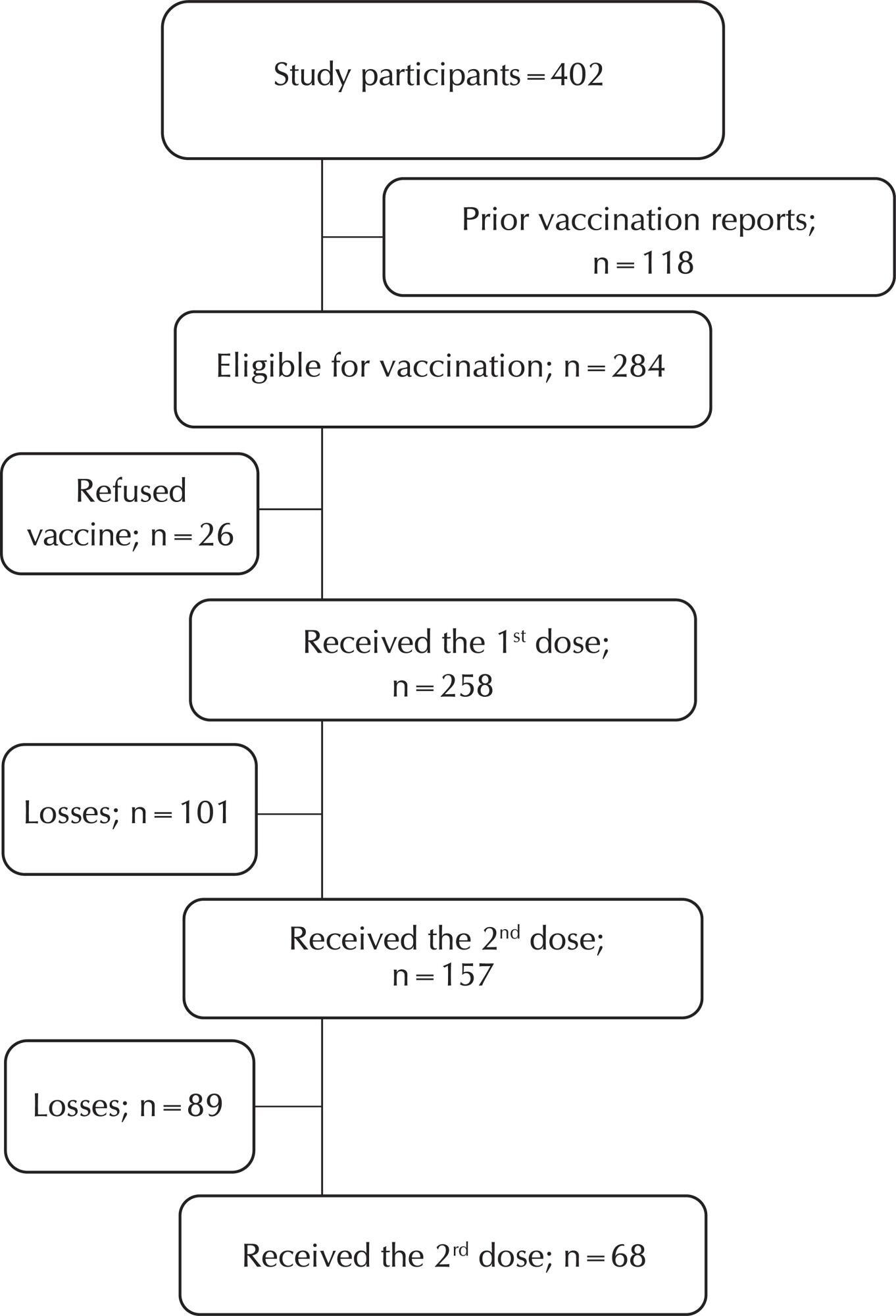
-
RESEARCH01-01-2017
Cost of nursing most frequent procedures performed on severely burned patients
Revista Brasileira de Enfermagem. 2017;70(3):481-488
Abstract
RESEARCHCost of nursing most frequent procedures performed on severely burned patients
Revista Brasileira de Enfermagem. 2017;70(3):481-488
DOI 10.1590/0034-7167-2015-0034
Views0See moreABSTRACT
Objective:
to identify the mean direct cost (MDC) of the most frequent procedures performed by nursing professionals on severely burned patients in an Intensive Care Unit.
Method:
exploratory-descriptive quantitative single-case study. The MDC was calculated by multiplying time (timed) spent by nursing professionals in the performance of the procedures by the unit cost of direct labor, and adding the costs of material and medicine/solutions.
Results:
a MDC of US$ 0.65 (SD=0.36) was obtained for “vital signs monitoring”; US$ 10.00 (SD=24.23) for “intravenous drug administration”; US$ 5.90 (SD=2.75) for “measurement of diuresis”; US$ 0.93 (SD=0.42) for “capillary blood glucose monitoring”; and US$ 99.75 (SD=129.55) for “bandaging”.
Conclusion:
the knowledge developed can support managerial decision-making, contribute to the efficiency distribution of the resources involved and, when possible, provide cost-containment or cost-minimization strategies without impairing the quality of nursing care.
-
RESEARCH01-01-2017
Nursing Activities Score and Acute Kidney Injury
Revista Brasileira de Enfermagem. 2017;70(3):475-480
Abstract
RESEARCHNursing Activities Score and Acute Kidney Injury
Revista Brasileira de Enfermagem. 2017;70(3):475-480
DOI 10.1590/0034-7167-2016-0266
Views0See moreABSTRACT
Objective:
to evaluate the nursing workload in intensive care patients with acute kidney injury (AKI).
Method:
A quantitative study, conducted in an intensive care unit, from April to August of 2015. The Nursing Activities Score (NAS) and Kidney Disease Improving Global Outcomes (KDIGO) were used to measure nursing workload and to classify the stage of AKI, respectively.
Results:
A total of 190 patients were included. Patients who developed AKI (44.2%) had higher NAS when compared to those without AKI (43.7% vs 40.7%), p <0.001. Patients with stage 1, 2 and 3 AKI showed higher NAS than those without AKI. A relationship was identified between stage 2 and 3 with those without AKI (p = 0.002 and p <0.001).
Conclusion:
The NAS was associated with the presence of AKI, the score increased with the progression of the stages, and it was associated with AKI, stage 2 and 3.
-
RESEARCH01-01-2017
Nursing appointment and cardiometabolic control of diabetics: a randomized clinical trial
Revista Brasileira de Enfermagem. 2017;70(3):468-474
Abstract
RESEARCHNursing appointment and cardiometabolic control of diabetics: a randomized clinical trial
Revista Brasileira de Enfermagem. 2017;70(3):468-474
DOI 10.1590/0034-7167-2016-0352
Views0See moreABSTRACT
Objective:
to verify the effect of nursing appointment on cardiometabolic profile of people with Diabetes Mellitus type 2.
Method:
randomized controlled trial, developed with 134 individuals chosen for two groups: intervention and control. The intervention consisted of three nursing appointments alternated bimonthly, with two phone calls, over five months. The control group received usual care offered by the Health Unit. Data were collected through semi-structured interviews before and after the intervention, in addition to conducting laboratory tests.
Results:
after the intervention, a significant difference was shown in the amount of glycated hemoglobin (p = 0.006) and in the systolic blood pressure (p = 0.031), which were higher in the control group.
Conclusion:
besides being low-cost and easy to develop on the monitoring routine of people with diabetes, the intervention performed influenced positively the biochemical profile.
-
RESEARCH01-01-2017
Terms of the specialized nursing language for the care of ostomates
Revista Brasileira de Enfermagem. 2017;70(3):461-467
Abstract
RESEARCHTerms of the specialized nursing language for the care of ostomates
Revista Brasileira de Enfermagem. 2017;70(3):461-467
DOI 10.1590/0034-7167-2015-0058
Views0See moreABSTRACT
Objectives:
to identify terms of the specialized nursing language for the care of ostomates from the literature of the area, and to map the identified terms with terms of the International Classification for Nursing Practice (ICNP®).
Method:
descriptive study of quantitative approach guided by the guidelines for the elaboration of terminology subsets of the ICNP®. The terms were collected in 49 scientific articles, extracted using a computational tool, selected according to the relevance for the theme, and normalized and mapped with the ICNP®.
Results:
20,668 terms were extracted. The standardization process resulted in 425 relevant terms (151 were constant in ICNP® and 274 were not contained in ICNP®), of which 154 were similar, 19 were more comprehensive, 50 were more restricted, and 51 were not in concordance.
Conclusion:
the use of standardized language can minimize the ambiguities and redundancies identified in the mapping. The existence of terms not in concordance with the ICNP® reinforces the need for constant updating of this classification.
-
RESEARCH01-01-2017
Validation of an instrument regarding nursing intervention in patients in vasoactive therapy
Revista Brasileira de Enfermagem. 2017;70(3):453-460
Abstract
RESEARCHValidation of an instrument regarding nursing intervention in patients in vasoactive therapy
Revista Brasileira de Enfermagem. 2017;70(3):453-460
DOI 10.1590/0034-7167-2016-0254
Views0See moreABSTRACT
Objective:
to validate the content of a Standard Operational Procedure, regarding nursing interventions in emergency patients treated with vasoactive drugs.
Method:
methodological study, carried out from December 2015 to January 2016. Content validity was determined by 16 experts (13 nurses, 2 pharmacists and one biomedical scientist), who judged it through a four-point Likert scale. The items were evaluated in terms of: feasibility, objectivity, simplicity, clearness, pertinence and accuracy. The Content Validity Index was applied, accepting the value ≥ 0.90.
Results:
two rounds of evaluation were required to achieve the minimum index. The items were reviewed regarding writing, dilution, indication and replacement interval. The instrument was validated with 33 items and with total Content Validity Index of 0.99.
Conclusion:
the instrument was considered appropriate, fractionally and globally, for nursing care for the patient treated with vasoactive drugs in emergency, in a safe and reliable way.
Search
Search in:
Nuvem de Tags
Adolescente (85) Atenção Primária à Saúde (239) COVID-19 (91) Criança (91) Cuidados de Enfermagem (269) Educação em Enfermagem (151) Educação em Saúde (139) Enfermagem (930) Enfermagem Pediátrica (86) Estudantes de Enfermagem (77) Estudos de Validação (131) Família (87) Idoso (208) Promoção da Saúde (99) Qualidade de Vida (104) Saúde do Trabalhador (86) Saúde Mental (145) Saúde Pública (82) Segurança do Paciente (150) Tecnologia Educacional (100)



